I have been experimenting the basic location app provided by Google Play Services https://github.com/android/location-samples/tree/master/BasicLocation
From my understanding, the application returns the latitude and longitude as text views. However, I would like to get the latitude and longitude values as double, such that I can pass the values on to other functions and/or calculations.
The default MainActivity.java and screengrab of the normal output on my emulator are at the bottom of this post.
To try and get the latitude and longitude values as double, I have tried two methods:
- Get latitude and longitude as double
- Converting the latitude/longitude text views to a double
To try and read in the latitude and longitude values as double, I edited the getLastLocation() section as follows below.
private void getLastLocation() {
mFusedLocationClient.getLastLocation()
.addOnCompleteListener(this, new OnCompleteListener<Location>() {
@Override
public void onComplete(@NonNull Task<Location> task) {
if (task.isSuccessful() && task.getResult() != null) {
mLastLocation = task.getResult();
// lines added here
mLatitudeDouble = mLastLocation.getLatitude();
mLongitudeDouble = mLastLocation.getLongitude();
} else {
Log.w(TAG, "getLastLocation:exception", task.getException());
showSnackbar(getString(R.string.no_location_detected));
}
}
});
}
However, when I pass mLatitudeDouble and mLongitudeDouble to text view, just to check what each returns, both show null.
Alternatively, I tried to convert the latitude and longitude text views to double. To do this I first edited the text views such that only numbers were returned.
private void getLastLocation() {
mFusedLocationClient.getLastLocation()
.addOnCompleteListener(this, new OnCompleteListener<Location>() {
@Override
public void onComplete(@NonNull Task<Location> task) {
if (task.isSuccessful() && task.getResult() != null) {
mLastLocation = task.getResult();
mLatitudeText.setText(String.format(Locale.ENGLISH, "%s",
mLastLocation.getLatitude()));
mLongitudeText.setText(String.format(Locale.ENGLISH, "%s",
mLastLocation.getLongitude()));
} else {
Log.w(TAG, "getLastLocation:exception", task.getException());
showSnackbar(getString(R.string.no_location_detected));
}
}
});
}
Which initially gave an output which looks like this
However, when I tried to convert the text views to a double, using code below the app crashed without warning. This line of code was based on another post Converting TextView value to double variable
double mLatitudeTextDouble = Double.parseDouble(mLatitudeText.getText().toString());
I ran the app in debug mode and it looks like an error was caused by an empty string. The relevant line is posted below.
2019-10-24 16:44:55.996 22629-22629/com.google.android.gms.location.sample.basiclocationsample E/AndroidRuntime: FATAL EXCEPTION: main
Process: com.google.android.gms.location.sample.basiclocationsample, PID: 22629
java.lang.RuntimeException: Unable to start activity ComponentInfo{com.google.android.gms.location.sample.basiclocationsample/com.google.android.gms.location.sample.basiclocationsample.MainActivity}: java.lang.NumberFormatException: empty String
If anyone has any suggestions about how to get longitude and latitude values as double or can point me in the direction of relevant background reading it would be much appreciated and I can answer any questions if needed. Apologies if you read a post similar to this previously. I deleted a previous post because I thought it wasn't very clear.
App appearance when functioning normally
Default main activity
/*
Copyright 2017 Google Inc. All Rights Reserved.
<p>
Licensed under the Apache License, Version 2.0 (the "License");
you may not use this file except in compliance with the License.
You may obtain a copy of the License at
<p>
http://www.apache.org/licenses/LICENSE-2.0
<p>
Unless required by applicable law or agreed to in writing, software
distributed under the License is distributed on an "AS IS" BASIS,
WITHOUT WARRANTIES OR CONDITIONS OF ANY KIND, either express or implied.
See the License for the specific language governing permissions and limitations under the License.
*/
package com.google.android.gms.location.sample.basiclocationsample;
import android.Manifest;
import android.content.Intent;
import android.content.pm.PackageManager;
import android.location.Location;
import android.net.Uri;
import android.os.Bundle;
import android.provider.Settings;
import androidx.annotation.NonNull;
import com.google.android.material.snackbar.Snackbar;
import androidx.core.app.ActivityCompat;
import androidx.appcompat.app.AppCompatActivity;
import android.util.Log;
import android.view.View;
import android.widget.TextView;
import com.google.android.gms.location.FusedLocationProviderClient;
import com.google.android.gms.location.LocationServices;
import com.google.android.gms.tasks.OnCompleteListener;
import com.google.android.gms.tasks.Task;
import java.util.Locale;
/**
* Location sample.
* <p>
* Demonstrates use of the Location API to retrieve the last known location for a device.
*/
public class MainActivity extends AppCompatActivity {
private static final String TAG = MainActivity.class.getSimpleName();
private static final int REQUEST_PERMISSIONS_REQUEST_CODE = 34;
/**
* Provides the entry point to the Fused Location Provider API.
*/
private FusedLocationProviderClient mFusedLocationClient;
/**
* Represents a geographical location.
*/
protected Location mLastLocation;
private String mLatitudeLabel;
private String mLongitudeLabel;
private TextView mLatitudeText;
private TextView mLongitudeText;
@Override
public void onCreate(Bundle savedInstanceState) {
super.onCreate(savedInstanceState);
setContentView(R.layout.main_activity);
mLatitudeLabel = getResources().getString(R.string.latitude_label);
mLongitudeLabel = getResources().getString(R.string.longitude_label);
mLatitudeText = (TextView) findViewById((R.id.latitude_text));
mLongitudeText = (TextView) findViewById((R.id.longitude_text));
mFusedLocationClient = LocationServices.getFusedLocationProviderClient(this);
}
@Override
public void onStart() {
super.onStart();
if (!checkPermissions()) {
requestPermissions();
} else {
getLastLocation();
}
}
/**
* Provides a simple way of getting a device's location and is well suited for
* applications that do not require a fine-grained location and that do not need location
* updates. Gets the best and most recent location currently available, which may be null
* in rare cases when a location is not available.
* <p>
* Note: this method should be called after location permission has been granted.
*/
@SuppressWarnings("MissingPermission")
private void getLastLocation() {
mFusedLocationClient.getLastLocation()
.addOnCompleteListener(this, new OnCompleteListener<Location>() {
@Override
public void onComplete(@NonNull Task<Location> task) {
if (task.isSuccessful() && task.getResult() != null) {
mLastLocation = task.getResult();
mLatitudeText.setText(String.format(Locale.ENGLISH, "%s: %f",
mLatitudeLabel,
mLastLocation.getLatitude()));
mLongitudeText.setText(String.format(Locale.ENGLISH, "%s: %f",
mLongitudeLabel,
mLastLocation.getLongitude()));
} else {
Log.w(TAG, "getLastLocation:exception", task.getException());
showSnackbar(getString(R.string.no_location_detected));
}
}
});
}
/**
* Shows a {@link Snackbar} using {@code text}.
*
* @param text The Snackbar text.
*/
private void showSnackbar(final String text) {
View container = findViewById(R.id.main_activity_container);
if (container != null) {
Snackbar.make(container, text, Snackbar.LENGTH_LONG).show();
}
}
/**
* Shows a {@link Snackbar}.
*
* @param mainTextStringId The id for the string resource for the Snackbar text.
* @param actionStringId The text of the action item.
* @param listener The listener associated with the Snackbar action.
*/
private void showSnackbar(final int mainTextStringId, final int actionStringId,
View.OnClickListener listener) {
Snackbar.make(findViewById(android.R.id.content),
getString(mainTextStringId),
Snackbar.LENGTH_INDEFINITE)
.setAction(getString(actionStringId), listener).show();
}
/**
* Return the current state of the permissions needed.
*/
private boolean checkPermissions() {
int permissionState = ActivityCompat.checkSelfPermission(this,
Manifest.permission.ACCESS_COARSE_LOCATION);
return permissionState == PackageManager.PERMISSION_GRANTED;
}
private void startLocationPermissionRequest() {
ActivityCompat.requestPermissions(MainActivity.this,
new String[]{Manifest.permission.ACCESS_COARSE_LOCATION},
REQUEST_PERMISSIONS_REQUEST_CODE);
}
private void requestPermissions() {
boolean shouldProvideRationale =
ActivityCompat.shouldShowRequestPermissionRationale(this,
Manifest.permission.ACCESS_COARSE_LOCATION);
// Provide an additional rationale to the user. This would happen if the user denied the
// request previously, but didn't check the "Don't ask again" checkbox.
if (shouldProvideRationale) {
Log.i(TAG, "Displaying permission rationale to provide additional context.");
showSnackbar(R.string.permission_rationale, android.R.string.ok,
new View.OnClickListener() {
@Override
public void onClick(View view) {
// Request permission
startLocationPermissionRequest();
}
});
} else {
Log.i(TAG, "Requesting permission");
// Request permission. It's possible this can be auto answered if device policy
// sets the permission in a given state or the user denied the permission
// previously and checked "Never ask again".
startLocationPermissionRequest();
}
}
/**
* Callback received when a permissions request has been completed.
*/
@Override
public void onRequestPermissionsResult(int requestCode, @NonNull String[] permissions,
@NonNull int[] grantResults) {
Log.i(TAG, "onRequestPermissionResult");
if (requestCode == REQUEST_PERMISSIONS_REQUEST_CODE) {
if (grantResults.length <= 0) {
// If user interaction was interrupted, the permission request is canceled and you
// receive empty arrays.
Log.i(TAG, "User interaction was cancelled.");
} else if (grantResults[0] == PackageManager.PERMISSION_GRANTED) {
// Permission granted.
getLastLocation();
} else {
// Permission denied.
// Notify the user via a SnackBar that they have rejected a core permission for the
// app, which makes the Activity useless. In a real app, core permissions would
// typically be best requested during a welcome-screen flow.
// Additionally, it is important to remember that a permission might have been
// rejected without asking the user for permission (device policy or "Never ask
// again" prompts). Therefore, a user interface affordance is typically implemented
// when permissions are denied. Otherwise, your app could appear unresponsive to
// touches or interactions which have required permissions.
showSnackbar(R.string.permission_denied_explanation, R.string.settings,
new View.OnClickListener() {
@Override
public void onClick(View view) {
// Build intent that displays the App settings screen.
Intent intent = new Intent();
intent.setAction(
Settings.ACTION_APPLICATION_DETAILS_SETTINGS);
Uri uri = Uri.fromParts("package",
BuildConfig.APPLICATION_ID, null);
intent.setData(uri);
intent.setFlags(Intent.FLAG_ACTIVITY_NEW_TASK);
startActivity(intent);
}
});
}
}
}
}


